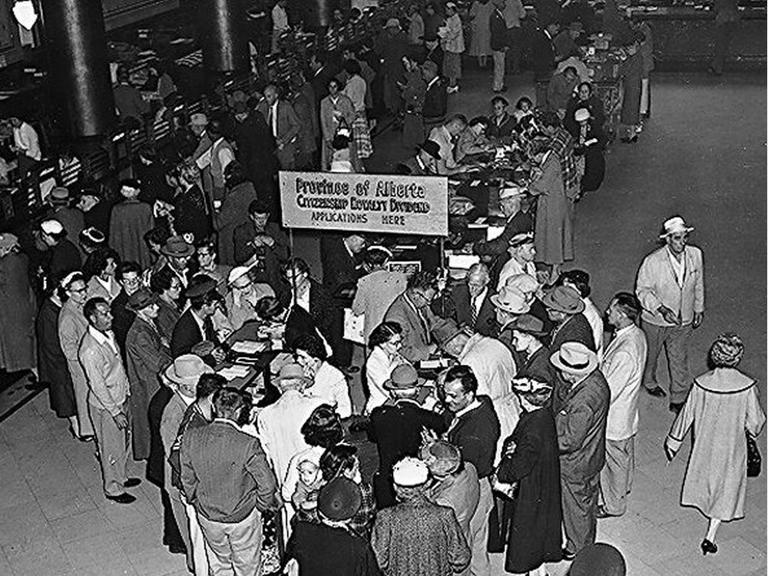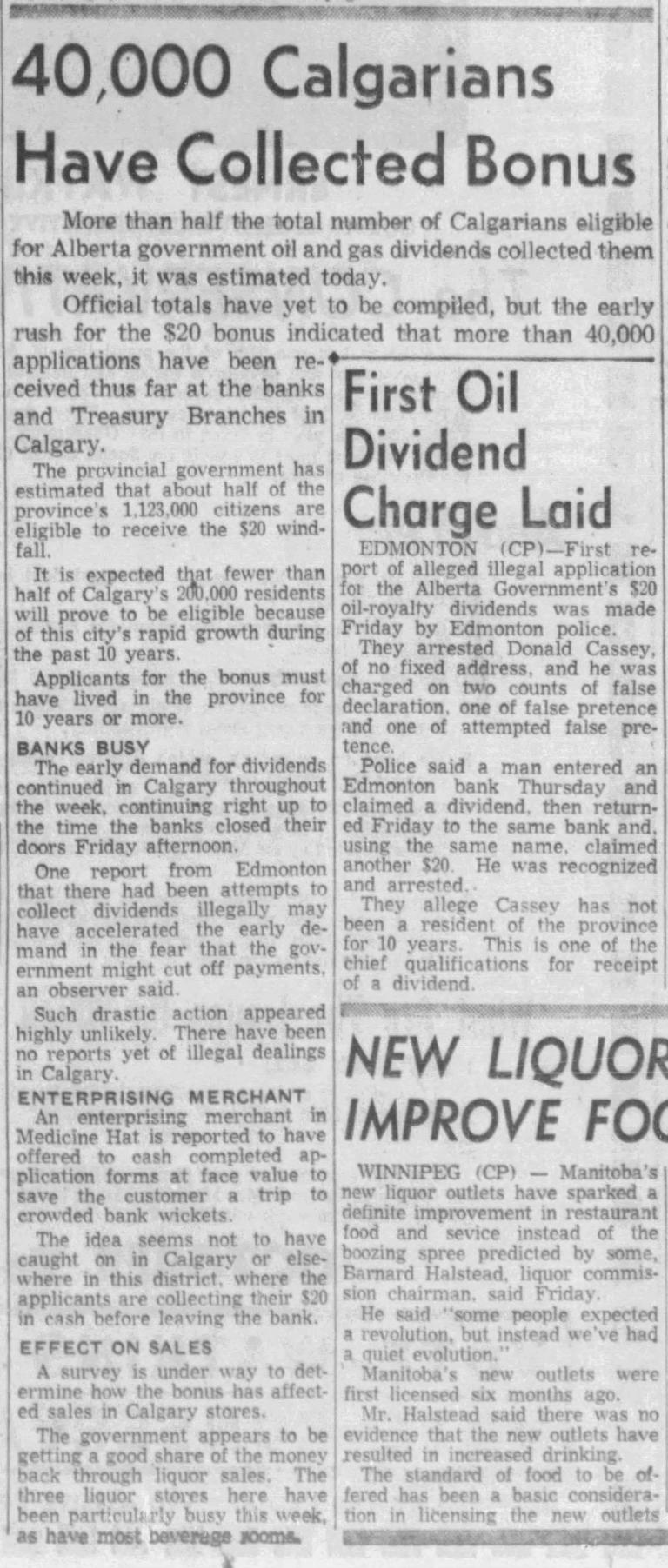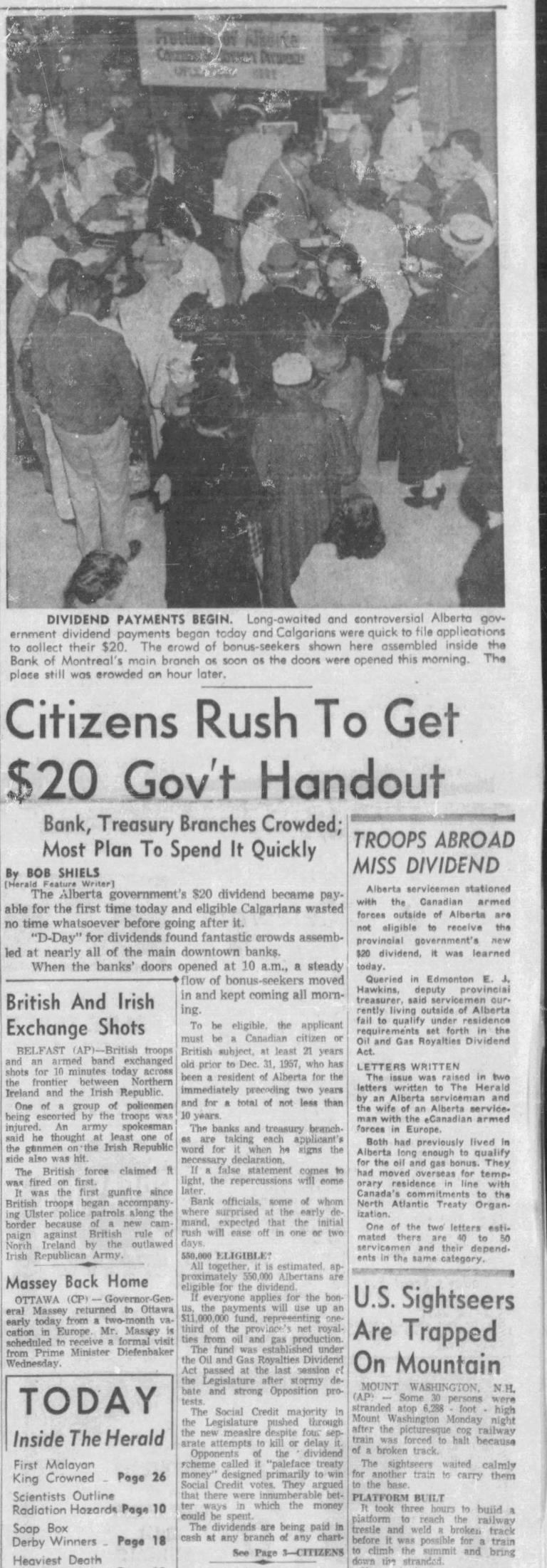Monica Zurowski, Calgary Herald -
There was a time when $20 had significant purchasing power. Just travel back in time 65 years. That’s when $20 could buy you two loaves of bread per week for the entire year or enough gas for your car for almost two months. Those 1957 prices now seem the stuff of dreams — $2,800 for a brand new car or $20,000 for a single family house in Canada’s most expensive cities.

Calgarians line up in September 1957 to get their $20 oil-and-gas bonus from the provincial government. This photo was taken at the Bank of Montreal's main branch as soon as doors opened on the first day bonuses were available. The bank had set up a special booth with four staff to do nothing but handle bonus requests. Calgary Herald archives.© Provided by Calgary Herald
Thus, many Albertans were thrilled when the provincial government decided to share proceeds from oil and gas windfalls, by offering citizens a $20 dividend bonus. Sixty-five years ago this month, Albertans were lining up to apply for the $20 bonus at banks and Treasury Branches. If you were 21 years of age or older and had lived in Alberta for at least a decade, you qualified.
To get an idea of how fast Alberta was growing at the time, the Social Credit government of the day estimated that only half of the province’s population of 1,123,000 would qualify for the bonus. As a Calgary Herald front page story noted on Sept. 7, 1957, “It is expected that fewer than half of Calgary’s 200,000 residents will prove to be eligible because of this city’s rapid growth during the past 10 years.”
The province planned to do a survey to see how the bonus was affecting sales in Calgary stores, but one early impact was being seen in government controlled liquor stores. “The government appears to be getting a good share of the money back through liquor sales,” stated the Herald story. “The three liquor stores here have been particularly busy this week, as have most beverage rooms.”
From the Calgary Herald; Sept. 17, 1957 front page

Calgary's three liquor stores busy, as province gives $20 oil dividend to Albertans: From the archives, 1957© Provided by Calgary Herald
A Calgary Herald story on Sept., 3, 1957, noted that if all eligible Albertans got the dividend, the program would cost the province up to $11 million , representing one-third of the province’s net royalties from oil and gas production. To get the bonus, citizens only needed to sign a statutory declaration that they were eligible to receive the dividend and provide identification. The dividends were then paid in cash to recipients.
Recommended video: Alberta anticipates $13B surplus due to high oil and gas pricesDuration 1:59 View on Watch
From the Calgary Herald; Sept. 3, 1957 front page

Calgary's three liquor stores busy, as province gives $20 oil dividend to Albertans: From the archives, 1957© Provided by Calgary Herald
While many Albertans welcomed the cash infusion, the plan had become controversial for some. Political opponents of the Social Credit government and Premier Ernest Manning said the plan was a tactic to buy votes and believed the money could be spent in a more productive manner for the province. Other Albertans said they’d rather see the money spent on education and health initiatives, but the government argued all Albertans were entitled to a share of the oil-and-gas windfall the province was experiencing. Working-class folks and average-wage earners greeted the dividend warmly.
From the Calgary Herald; March 5, 1957 front page

Calgary's three liquor stores busy, as province gives $20 oil dividend to Albertans: From the archives, 1957© Provided by Calgary Herald
Unfortunately, a number of opportunists — er, criminals — decided the dividend plan was fertile ground for committing fraud. An early case of someone convicted for making a false declaration and obtaining the citizen’s royalty by false pretences was a Calgary man, Angus Lera, who was sentenced to three months of hard labour in the Lethbridge jail. Another man, Roy Gordon Ohlhauser — a 24-year-old living in a downtown hotel — pleaded guilty in January 1958 to fraudulently obtaining 41 Alberta oil dividends. He received a six-month sentence, to be served concurrently, on each charge.
In the end, there was an estimated loss of $40,000 in fraudulent claims for the dividend, but critics suggested that dollar amount was actually higher. A Calgary Herald editorial on Feb. 12, 1958 questioned what the real losses were, giving a big thumbs down to the entire plan. “How many thousands of dollars were taken by clever crooks, who were able to switch identities and make claims will never be known,” the opinion piece stated.
The provincial government announced in February 1958 that the next round of dividends would be based on a slightly lower payout and that the process would be tighter, involving either “electrical sorting machines” or application punch cards, complete with an individual’s photo.
In August 1958, Premier Ernest Manning revealed a five-year development program for Alberta, with spending to be focused on schools, hospitals and municipalities. He also said the citizen’s oil and gas dividend program was being suspended, so that the $10 million that would have been spent on these dividends could instead be diverted to the aforementioned projects.
No comments:
Post a Comment